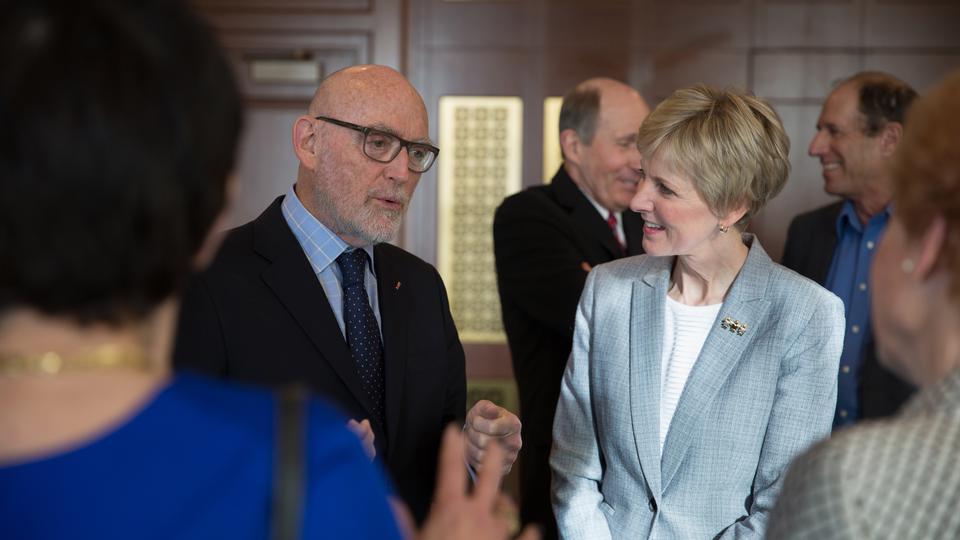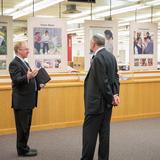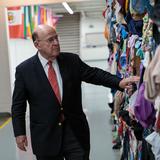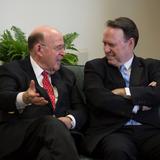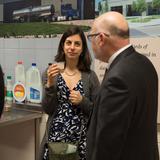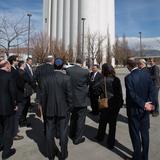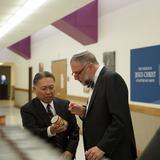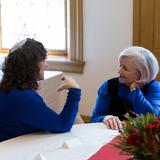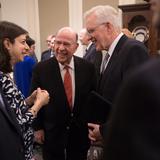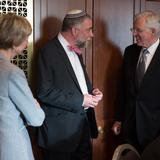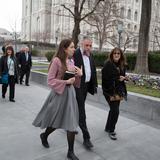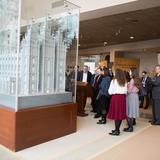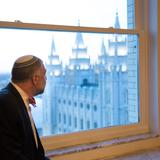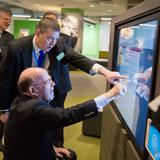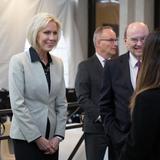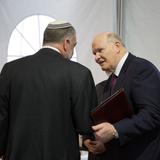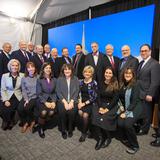| Temple Square is always beautiful in the springtime. Gardeners work to prepare the ground for General Conference. 2012 Intellectual Reserve, Inc. All rights reserved. | 1 / 20 |
Downloadable video: B-roll | SOTs
For Saba Soomekh, a Jewish leader from California, seeing firsthand The Church of Jesus Christ of Latter-day Saints’ welfare and temple operations is a way of practicing what she preaches to her university religious studies students.
To help them deepen their understanding of other faiths, she asks students to visit mosques, synagogues and other worship spaces.
“People just want to be understood,” said Soomekh, who teaches religious studies, women’s studies and Middle Eastern history at the University of California, Los Angeles. Soomekh, who is assistant director of interreligious and intercommunity affairs for the American Jewish Committee, was one of 11 Jewish leaders from Los Angeles and New York who visited with Latter-day Saint leaders Tuesday and Wednesday, touring the Church’s vast welfare facilities and the newly renovated Jordan River Utah Temple.
“It is so important to learn about other faiths, especially in the time that we're living in today where there is so much misunderstanding and so much animosity,” she continued. “It is so important to really truly understand what people believe, how it's not a threat to you and how you could work to better [the] community.”
This week’s visit is part of an ongoing series of relationship-building experiences between Latter-day Saints and Jews. In May 2017, Jewish leaders hosted Latter-day Saint leaders in New York City, and in October 2016, some members of this same Jewish delegation gathered in Jerusalem with Latter-day Saint leaders to commemorate the 175th anniversary of an early Latter-day Saint apostle’s journey to Jerusalem.
While this wasn’t Soomekh’s first interaction with The Church of Jesus Christ of Latter-day Saints (she has taught about the Latter-day Saint religious tradition for 13 years, has developed relationships with Latter-day Saint leaders in California and attended President Monson’s funeral), she said she is grateful for the education received during this latest round of interfaith interaction.
“I only become a better professor because I get to say I experienced this firsthand,” she said. “Just to see the way everything works out [at Welfare Square] and how the organizational aspect of it, the voluntary aspect of it — it is so impressive and something that I think every religious tradition — and not even faith communities, but everyone — should participate in, and we can learn a lot from the LDS community in this way.”
The delegation toured the Jordan River Utah Temple (located 15 miles south of downtown Salt Lake City) on a rainy Wednesday afternoon. Former New York Attorney General Robert Abrams, who toured several Latter-day Saint temples in years past, said he was once again struck by the sacred structure’s Jewish connection.
“To go through this temple today and to see so many of the Jewish Old Testament themes found in this temple and memorialized in this temple — it just really reaffirms the connection between [Jews and Latter-day Saints],” Abrams said. “And there's a powerful feeling of peace when you come out of the temple.”
Such interfaith outreach yields durable fruit, said Elder D. Todd Christofferson of the Quorum of the Twelve Apostles, who has nurtured personal relationships with Jewish leaders since the early 2000s. “Only good can come out of mutual understanding,” he said. “And as we know each other better, we resolve conflicts that might exist, we avoid conflicts and we're able to collaborate in doing good things together. It multiplies our capacity, I think, on all sides to accomplish our own ministry. And we're just better people with that kind of association.”
Elder Christofferson and Sister Jean B. Bingham, the Church’s Relief Society general president, joined the Jewish delegation at a dinner Tuesday night. Afterward, Sister Bingham spoke of growing up in New Jersey attending seders and Shabbat services with Jewish friends, and later as a Latter-day Saint seminary instructor in Chicago for six years. She spent two of those years teaching the Old Testament, where she learned about Jewish holidays such as Purim, Rosh Hashana and Yom Kippur.
“The way to reach out to people of other faiths is to look for the things that we have in common and appreciate them,” Sister Bingham said. “Yes, there are always things that are different, but even those things can be interesting when you find out more about a particular person. In a one-on-one conversation you find there are many things that you enjoy and that you can really actually love about another person.”
Elder Christofferson said this week’s face-to-face interfaith outreach can be a pattern for everyday Latter-day Saints, as well as people of other faith or no faith.
“We talk about communities getting together in organizations and so on, but really it's the people within those communities, within those organizations, and their individual relationships that make the kind of difference that we're talking about,” Elder Christofferson said. “Everyone ought to feel they can have a part. … When they don't have the capacity to range across the world, if they do it locally in their neighborhood and they reach out and they invite people over and they take advantage of the opportunities that are quite naturally there, that's what we're looking for.”
